The hummingbird food sugar ratio is 1 part sugar to 4 parts water
Here you’ll learn to make hummingbird food, how to clean a feeder, when to change the nectar, how to keep ants, bees and wasps away from your feeder, how to attract hummingbirds into your yard and much more.
Making your own hummingbirds nectar is just one more way you can add to your personal joy of bird watching.
Making homemade hummingbird food is really very easy and only takes a few minutes to do. Add that to the fact that you can even save a little bit of money, have nectar that is healthier for the hummingbirds and suddenly there is plenty of reason why you would want to learn how to make homemade hummingbird food.
There is a kind of satisfaction you will get from watching the hummingbirds visiting your feeder and enjoying the hummingbird nectar that you yourself have made.
The Importance of the Right Sugar Ratio
Why Sugar Ratio Matters
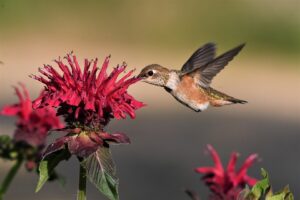
Using the wrong ratio can have adverse effects. Too much sugar can lead to dehydration or liver damage in hummingbirds, while too little sugar won’t provide enough energy. Additionally, avoid using honey, artificial sweeteners, or brown sugar, as these can be harmful to birds.
Hummingbird Food Sugar Ratio Instructions:
hummingbird nectar ingredients
- tap water
- granulated white table sugar
When you make your own hummingbird food you will want to get it as close as you can to the real flower nectar found in nature. To get your hummingbird nectar to taste like the real thing, you will need a ratio of 1 part sugar to 4 parts water. I part granulated white table sugar to 4 parts tap water.
Hummingbird Food instructions
- Put the 4 parts water in a pan on your stove top and bring to a boil.
- Stir in the 1 part sugar and continue stirring until the sugar is dissolved. Let the mixture boil for 2 minutes.
- Take the pan of hummingbird food off the heat and let the nectar cool.
Boiling for 2 minutes is long enough to kill any mold spores and bacteria that might be in the sugar, which might cause the nectar to ferment quicker once it’s in the feeder. Boiling will also release any chlorine out of the water. Don’t boil longer than 2 minutes or the ratio of sugar to water will be changed, resulting in a sweeter mixture that would be more attractive to bees and wasps.
Now you can fill your feeder and store any excess nectar in the refrigerator. Your excess nectar will stay fresh for a week or so in the refrigerator and can be used when needed.
Just white granulated sugar and water, no other ingredients are added. Red food coloring, according to some, may be bad for the hummingbirds, so to be on the safe side don’t use it in your nectar recipe. The red color of your feeder will be plenty of red to attract hummingbirds.
Here is a video about how to make hummingbird food
Now that you know how to make nectar the only other thing you need to do is to be sure to keep fresh nectar in your feeder. Hummingbirds won’t come to a feeder that doesn’t contain fresh nectar. Sooner or later, heat from the outside air will cause the sugar in the nectar to ferment. Eventually the fermented nectar will produce mold and bacteria that will harm the hummingbirds and make a mess out of your feeder.
When to change the hummingbird food in the feeder
The way to keep your hummingbird nectar fresh is to change the nectar every so often. As a general rule: If the temperature doesn’t get above 70 you will probable be able to go a week without changing the nectar. Once the temperatures begin to rise you can follow the guide below too give you an idea of when the nectar might need to be changed.
Guide for when to change the nectar
Letting the nectar ferment encourages mold growth, which makes the cleaning process more difficult. To avoid this, follow the chart below for recommended nectar changes based on the temperature. The hotter it gets, the more frequently you’ll need to replace the nectar.
High temperatures…………Change after
71-75……………………………6 days
76-80……………………………5 days
81-84……………………………4 days
85-88……………………………3 days
89-92……………………………2 days
93+………………………………change daily
Click on the link for a detailed guide to help you clean your hummingbird feeder, especially when mold starts to grow due to nectar not being changed in time.
These are only general guidelines just to give you an idea of how often you will have to change you nectar. A visual inspection of the nectar in your feeder along with the chart will tell you when to change it. It’s always better to change the nectar a little earlier than you have to than to risk waiting to long and then have to clean mold out of your feeder. Visually check the nectar in your feeder and whenever it starts to look cloudy, that is an indication that it needs to be changed right a way.
Each time you change the nectar:
Rinse the feeder out with hot water. The National Audubon Society says that you should clean your feeder once a week. They suggest to rinse your feeder out with a vinegar solution containing 1 part white vinegar to 4 parts water. Follow the vinegar wash by rinsing your hummingbird feeder three times with clear warm water before refilling with fresh sugar solution.
If you see black spots of mold growing in the nectar or growing on the feeder, you have waited too long and should have changed it sooner.
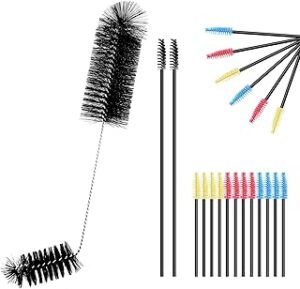
Once mold starts to grow in your feeder you will have to sterilize the feeder. You will have to soak your feeder in a mild bleach water solution consisting of 1/4 cup bleach to 1 gallon of water. Soak your feeder in the bleach solution for an hour to kill the mold. To help clean out the mold it is helpful to use hummingbird feeder brushes that will allow you to reach inside the feeder and into the feeder holes. Brush out any mold you find and then soak the feeder.
When your hummingbird feeder is done soaking, thoroughly rinse the feeder with water 3 or 4 times to make sure all traces of the bleach water are gone.
Here is a good video on cleaning a hummingbird feeder that might be helpful.
How to keep feeder pests off of your hummingbird feeder
The sweet sugar syrup that you use to attract hummingbirds will also attract other unwanted visitors like bees ants and wasps. Some of your best hummingbird feeders will have built in features to keep pests away. If your feeder doesn’t, and you are having problems with pests at your feeder, there are a few steps you can take to ease the problem.
How to keep ants off a hummingbird feeder
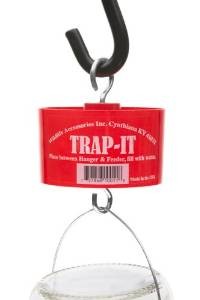
Ants don’t seem to have any problem locating a feeder. Partially because a lot of feeders will leak and the nectar runs down the feeder and onto the ground, leaving a good trail of sweet nectar for the ants to follow. Using a leak-proof feeder is a good place to start.
Inverted bottle feeders, that have a bottle of nectar that screws into the base of the feeder, is usually the problem with a leaky feeder. As the nectar level decreases in the bottle, an air pocket forms at the top of the bottle. Heat will cause the air in the pocket to expand and that will force nectar to run out of the feeding ports down below the bottle.
The other main type of feeder, that doesn’t leak, is the basin feeder. The basin feeder looks like a dish, that has a lid containing the feeding ports, that covers the dish. In this type of feeder the nectar level is always far below the feeding ports and can’t be forced out with air pressure. A basin feeder is a good feeder to help keeps ants away.
The main thing that will keep ants away from a hummingbird feeder is an ant moat.
Ant moat
An ant moat for a hummingbird feeder is a small container that holds water. Some feeders have ant moats built into the design of the feeders. For those that don’t, the moat is placed between the feeder hook and the feeder itself. When the moat is filled with water the ants can crawl down the feeder hanger until they reach the water and then, because they can’t swim, the ants can’t go any further. Your nectar is safe. If ants get into your nectar they will drown and their decomposing bodies will ruin your nectar.
A red ant moat will also help to attract hummingbirds to your feeder.
Here’s a video on how to make your own ant moat.
How to keep bees, wasps and other flying insects off a hummingbird feeder
The ant moat will fix the ant problem, but how do we keep bees and wasps off of the hummingbird feeder? Once again, a good feeder will have barriers to bees and wasps off, built into the design of the feeder. For other feeders, there are a few other things you can do to hopefully keep them away.
*some feeders come equipped with yellow plastic mesh bee guards over the feeder ports. Unfortunately, these are usually bottle feeders that drip and the yellow in the bee guards is attractive to bees and wasps.
*try moving the feeder a short distance. Sometimes the bees and wasps won’t see it and will think it’s gone.
*try taking down the feeder down for several days until the bees ans wasps leave the area.
*put up a feeder just for the bees and wasps so they will leave the hummingbird feeder alone. Use a sweeter nectar ratio of 1 part sugar to 3 parts water. The bees and wasps will like the sweeter solution better and hopefully leave the hummingbird feeder alone.
Bee proof your hummingbird feeder, video
Here’s a video about how one man made bee guards out of the plastic mesh from onion sacks.
Best hummingbird feeder to insure you success at feeding hummingbirds
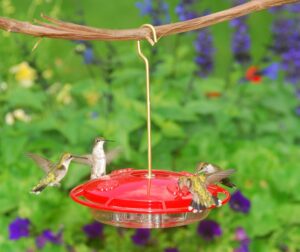
The best way to go is to get the best hummingbird feeder you can find that has plenty of built-in design features that make your job as easy as possible.
Of course you’ll want a non-leaking feeder that has an ant moat and bee guards to keep out insects. You’ll want a feeder that is easy to clean. You’ll want a red feeder to attract the hummingbirds and you’ll want a feeder with a perch so the hummingbirds can rest and conserve energy a they feed. And, raised feeding ports are nice to keep rain water out of your nectar so it isn’t diluted. Red, raised ports instead of the yellow flowers that are so common. Yellow attracts bees and wasps.
I’ve found a feeder that has all of these features and is also inexpensive. The Hummzinger Ultra is a 12 oz. hummingbird feeder with all the bells and whistles! To keep out bees and wasps, it has patented “Nectar Guard Tips”. They are flexible membranes that fit into the underside of the feeding ports. They let in hummingbird beaks, but close up when the beak is removed and keep out the bees and wasps.
Below is a video of the Hummzinger feeder. Notice at the 2:35 mark that a bee is checking out the feeder ports , but gives up and leaves when it can’t gain entry to feed. You can see the ant moat around the bottom of the hanger. A perch encircles the feeder and you can see the raised, red, rain guards on the feeder ports. It comes apart in the middle for easy cleaning access. Because of it’s ease in cleaning, it’s protection from pests and all the other features, this is my first choice in hummingbird feeders.
Advanced Tips for Hummingbird Enthusiasts: Creating a Hummingbird-Friendly Garden
Beyond feeders, creating a garden that attracts hummingbirds involves planting nectar-rich flowers and providing shelter. Here are some advanced tips to transform your garden into a hummingbird haven:
Flower Selection
Choose flowers that bloom at different times to ensure a constant nectar supply throughout the year. Some excellent options include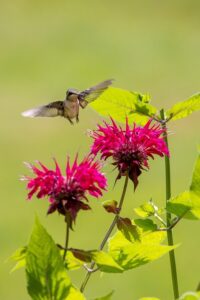 :
:
-
Spring: Trumpet honeysuckle and pineleaf penstemon
-
Summer: Bee balm, red hot poker, and daylilies
-
Fall: Summersweet and late-blooming annuals
Plant large masses of flowers, as a strong splash of color created by five to ten plants together is more visible to passing hummingbirds.
Shelter and Nesting Sites
Incorporate shrubs or trees that offer protection from wind and predators. Consider the following:
-
Leave some thorny plants unpruned, as hummingbirds often prefer to nest in them for extra protection.
-
Keep some bare branches on shrubs or trees as perches for hummingbirds.
-
Plant conifers, shade trees, and taller shrubs to provide sheltered spots for resting and nesting.
- Here’s a complete guide to attracting hummingbirds to your yard. It lists plants, vines and shrubs that are in bloom for spring, summer and fall. Your hummingbirds will always have flowers to feed on.
Advanced Garden Design
-
Vertical gardening: Use trellises, trees, and structures to support climbing vines, creating a multi-layered habitat.
-
Water features: Add a shallow fountain, mister, or fine spray to provide bathing opportunities for hummingbirds.
-
In addition to nectar, hummingbirds need water.
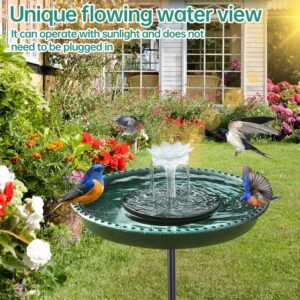
solar powered fountain birdbath Water Sources
Hummingbirds enjoy fresh water to drink and bathe. A shallow birdbath with a fine spray from a mister is ideal. Just make sure the water is changed regularly to keep it clean.
Here’s a solar powered bird bath.Hummingbird misters at Amazon.com
-
Nesting materials: Offer fuzzy plants like cinnamon fern and pussy willow, and leave some thistle and dandelion in your yard for nest-building.
- Click here for a full line of nesting material
-
Insect-friendly practices: Minimize pesticide use, as hummingbirds rely on insects for protein, especially when feeding their young.
-
Strategic feeder placement: Hang feeders at different heights and locations, keeping them at least 7 feet apart and higher than 6 feet off the ground.
Maintenance and Safety
-
Regularly deadhead faded blooms to encourage continuous flowering.
-
Avoid using pesticides, herbicides, and chemical fertilizers near your hummingbird garden.
-
Consider keeping cats indoors to create a safer environment for hummingbirds.
By implementing these advanced techniques, you’ll create an irresistible sanctuary that will attract and support hummingbirds throughout the seasons.
Tips for Attracting Hummingbirds: Setting Up Feeding Stations
To maximize your chances of attracting hummingbirds, it’s crucial to set up your feeding stations strategically. Here are some detailed tips to help you create an inviting environment for these beautiful birds:
Location
-
Shaded Areas: Place feeders in shaded areas to prevent the nectar from spoiling too quickly. Direct sunlight can cause the nectar to ferment, which may attract unwanted pests and deter hummingbirds.
-
Near Flowers: Position feeders near nectar-rich flowers to create a hummingbird-friendly zone. This combination will attract hummingbirds and encourage them to stay longer in your garden.
-
Away from Predators: Keep feeders away from windows, cats, and other potential predators to ensure the safety of visiting hummingbirds.
Here’s a great article that tells everything you need to know about how to choose the best place to hang your hummingbird feeder.
Height
-
Eye Level or Higher: Hang feeders at eye level or slightly higher for easy visibility. This height also helps prevent larger birds and other animals from accessing the feeders.
-
Accessibility: Ensure that the feeders are accessible for refilling and cleaning without having to climb or stretch excessively.
Cleanliness
-
Regular Cleaning: Clean feeders thoroughly at least once a week (or more often in hot weather) to prevent mold and bacteria growth. Use a mixture of water and vinegar to rinse the feeders.
-
Nectar Replacement: Replace the nectar every three to five days to maintain freshness and prevent spoilage.
Additional Tips
-
Feeder Variety: Use a variety of feeder types, such as tube feeders and saucer feeders, to cater to different hummingbird preferences.
-
Nectar Recipe: Use a simple nectar recipe of four parts water to one part sugar. Avoid using honey or artificial sweeteners, as they can be harmful to hummingbirds.
-
Feeder Placement Strategy: Hang multiple feeders at different locations around your garden to reduce competition among hummingbirds and encourage more visits.
By following these tips, you can create an attractive and safe feeding station that will draw hummingbirds to your garden and keep them coming back.
Bully Hummingbirds! How to Reduce Aggression and Aggressive Males
Frequently Asked Questions
What is the best sugar-water ratio for hummingbirds?
The ideal ratio is 1 part white granulated sugar to 4 parts water. This formula closely resembles natural flower nectar and provides the energy hummingbirds need without harming their health.
Can I use honey or artificial sweeteners?
No, honey should never be used because it ferments quickly and can cause fungal infections in hummingbirds. Artificial sweeteners lack the calories and nutrients needed by these high-energy birds.
Should I add red dye to the nectar?
No, adding red dye is unnecessary and potentially harmful. Most feeders already have red accents that naturally attract hummingbirds.
How often should I clean my feeder?
Feeders should be cleaned at least once a week under normal conditions or every two days during hot weather. Dirty feeders can harbor mold and bacteria that are dangerous for hummingbirds.
What types of flowers attract hummingbirds?
Hummingbirds are attracted to flowers with high nectar content, particularly those with trumpet-shaped blooms like honeysuckle, fuchsia, and trumpet vines.
Can I make hummingbird food without sugar?
No, sugar is essential for providing the energy hummingbirds need. However, always use white granulated sugar and avoid substitutes.
Conclusion:
Now you know the hummingbird food sugar ratio and how to make your own hummingbird nectar. You also know how to keep your feeder clean and when to change the nectar. You know how to keep away bees, ants and wasps, what to look for in a good hummingbird feeder and helpful gardening tips. Now you have all the information you need to insure your success in attracting hummingbirds to your feeder and to keep them coming back for more! Enjoy!
If you found this article helpful please share it using the social bookmarking buttons on the left side of this page. You can help everyone to increase their enjoyment of hummingbirds. Do it for the hummingbirds!
Hummingbird Resources
U.S. Fish and Wildlife Service – Hummingbird Conservation
This site offers detailed information about various hummingbird species, their habitats, and conservation efforts. It also provides resources on how to protect these fascinating birds.
National Park Service – Hummingbird Resources
The National Park Service offers insights into hummingbird species found in national parks, their behaviors, and their role in ecosystems, along with tips for observing them.
Smithsonian National Museum of Natural History – Birds: Hummingbirds
This resource provides educational materials on the role of hummingbirds in pollination and biodiversity, backed by scientific research and exhibits from the Smithsonian.
U.S. Geological Survey – Hummingbird Studies
The USGS offers research on hummingbird migration patterns, population dynamics, and environmental threats, including studies on climate change impacts.
The Cornell Lab of Ornithology – Hummingbirds
While not strictly a government site, Cornell partners with federal agencies to provide valuable scientific insights into hummingbird behavior, conservation, and field guides.

